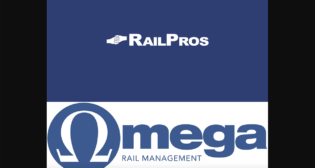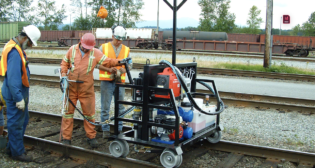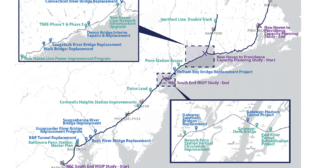
Conquering Rolling Contact Fatigue and Gage Corner Cracking
Written by Douglas John BowenEddy Current inspection may be a technology whose time has come.
 RCF is due to a ratcheting of each loading cycle (wheel pass), which exhausts the ductility of the steel and eventually generates an incipient crack. If a rail wears faster than RCF generates cracks, then there is no problem other than the fact that rails are prematurely replaced due to wear instead of flaws. Most infrastructure owners would prefer a balance where they can get the most life possible from their rail. Although we are addressing rail RCF specifically, wheel RCF is also a concern that should not be overlooked. As the British experienced in 2000, this rail condition, if left unattended, can have catastrophic consequences. This is the actual rail (pieced back together) that was the cause of the Hatfield derailment that killed multiple passengers and brought the entire U.K. network to a grinding halt.
RCF is due to a ratcheting of each loading cycle (wheel pass), which exhausts the ductility of the steel and eventually generates an incipient crack. If a rail wears faster than RCF generates cracks, then there is no problem other than the fact that rails are prematurely replaced due to wear instead of flaws. Most infrastructure owners would prefer a balance where they can get the most life possible from their rail. Although we are addressing rail RCF specifically, wheel RCF is also a concern that should not be overlooked. As the British experienced in 2000, this rail condition, if left unattended, can have catastrophic consequences. This is the actual rail (pieced back together) that was the cause of the Hatfield derailment that killed multiple passengers and brought the entire U.K. network to a grinding halt.
Factors that cause GCC have become a subject that industry experts contemplate, evaluate, and refine on a regular basis. The basic premise is that Longitudinal Steering Forces, which are a function of lateral wheelset shift, Lateral Wheel/Rail Forces, which are a function of axle Angle of Attack (AoA), and Vertical Load from static weight and dynamic movement all play a key role along with material properties and operational conditions. Now introduce a few more variables such as lubrication, wheel/rail profiles, track curvature and alignment, cant deficiency (train speed/superelevation), primary yaw stiffness (holds axles parallel), and changes from system wear just to ensure that the problem is not too easy to evaluate and address.
There is an ICRP (International Collaborative Research Program) addressing this subject in detail. Research personnel from around the globe are coming together to share experience, data, and resources. More information on this subject can be found at www.railadvisor.com, search term “magic wear rate.”
While there are a handful of engineers working on the subject of cause and effect, railway management and track crews have the job of maintaining their systems along with measuring and monitoring on a daily basis to ensure safe and efficient rail conditions. Even though the measurement and management tools are not perfect, we have to tip our hats to the crews with boots on the ground that are trying to mitigate this problem to the best of their ability. The railroad doesn’t usually stop just because a couple components have a few small cracks—or does it?
At one time in the not so distant past, the operating condition and material properties of the wheel/rail interface caused rail to wear at a rate fast enough to wear away most surface cracks. Today’s materials are lasting much longer, and the good news is that we are doing more with less. Our long lasting assets are allowing us to run more efficient operations, but they come with a tradeoff. This efficiency is not free. We are trading our old problems and concerns for new ones. In this case, we can run heavier trains and still enjoy longer rail life at the cost of increased crack growth, which must be managed to ensure safe and efficient operations.
GCC has become more common in North America in recent years due to many factors. The most common remedy for GCC management is the implementation of a grinding program that removes just enough railhead to eliminate the cracks but not so much that good rail is ground into dust and discarded by way of the drainage ditch. This “magic wear rate” refers to the rate of wear (both natural and artificial) required to optimally manage RCF. It is a simple concept that recognizes that when there is no wear, the rail will fail due to RCF, but when there is excessive wear, asset life is unnecessarily wasted. This is the basis for preventive rail grinding programs worldwide.
While grinding programs are more and more prevalent, the tools to ensure proper grinding (GCC related) have been missing until just recently. Since there has been no way to tell just how deep a series of cracks might be, most grinding programs have relied on local knowledge and a bit of educated trial and error. New on the scene are Eddy Current inspection devices. Although Eddy Current has historically been one of the technologies that has experienced difficulty measuring accurately in the field, there are a few case studies that are bringing hope to this inspection method and giving confidence that measuring and monitoring GCCs is a reality whose time has come.
The development of a manually pushed Eddy Current system has been in process for some time. Testing in Germany, Europe, and North America has resulted in the Deutsche Bahn’s (DB) approval (March 2011) of the “Manual Eddy Current Test Instrument WPG D340” or “Draisine” (the German word for trolley). The Draisine is a four-channel Eddy Current instrument with adjustable probes set to measure the gage corner and head of rail for surface flaws including such flaws caused by RCF. Actual surface and near surface condition is measured, stored, and processed real-time for rapid evaluation of the rail surface condition. This measurement device provides information to include flaw location and calculated damage depth, which can aid in grinder operations and assessments.
North American testing and trials began early in 2011 at TTCI. Early in 2012, the DB approved the full production version of the Draisine for use on all DB track in Germany. 2012/2013 saw further testing at TTCI as well as at the Union Pacific Western Mega Site and the Norfolk Southern Eastern Mega Site for pre and post grind RCF/GCC measurement evaluation. NS was instrumental in providing yet another location where pre and immediate post grind measurements were taken to ensure that the inspection device could “see through” surface grinding marks. The following information is from the NS Virginia Division.
• Curvature: 6 degrees.
• Superelevation: 3.5 inches.
• Rail size: low 141RE, high 136RE.
• Rail age/installed: low 2003, high 2010.
• Tie: wood.
• Fastener: Victor 8 x 18-inch plates with Pandrol clips.
• Ballast: granite.
• Annual tonnage: 41 MGT.
• Typical number of railcars with power: Vast majority of traffic is eastbound loaded coal trains with two six-axle locomotives pulling 120 cars (no DP or helper).
• Average train speed through the curve: Timetable speed 35 mph, figure actual speed between 30 and 34 mph.
• Braking/accelerating: Steady pull due to level grade.
• No repeating annual maintenance requirements or issues.
Pre-grind data was gathered from both high and low rails over a 400-meter section of curves, including two bridges that had not been ground for some time due to fire hazard concerns. The grinding train was scheduled to make five passes on the low rail and two passes on the high rail based on the NS grinding plan (historic) and profile objectives. To further evaluate the measurement system, a section of low rail was identified, and measurements were taken immediately after each of the five grinding passes. With each pass of the grinding train, a slight reduction in the RCF damage depth was measured. Even after the fifth pass, some minor damage was observed visually. If it were not for the Eddy Current system, there would be no way to know if these residual cracks were half a millimeter deep (non issue) or 10 millimeters deep (serious problem).
Conclusions made at the end of the pre/post grinding measurement sessions were that the Draisine was able to accurately measure the surface cracks and it was also able to “see through” the surface irregularities caused by the grinder. Further validation was required to confirm the actual crack length, angle, and depth.
Subsequent testing of four random sections of rail were measured with the Draisine and then removed from track and sent to the NS lab where actual crack length, angle, and depth were measured. Each of the 18-inch sections removed were sliced into one-inch sections and polished for evaluation under the electron microscope. Measured crack length, angle, and corresponding damage depth were compared to the Eddy Current measurements. These images are magnified to show the multiple branches of cracks as well as the specific crack angle. The other three sections were evaluated in the same manner with the field vs. lab results within 10% of each other in all cases.
As a result of the combined testing in Europe and in North America, there is now a legitimate level of confidence that the Draisine Eddy Current system can be reliably utilized as a pre and post grind management tool for accurately measuring surface crack length and calculated depth based on crack angle. Systems such as this can be utilized to provide field services and management personnel a greater level of confidence that one of the most expensive assets on the railway is properly maintained. With recent advancements in Eddy Current inspection technologies, higher speed versions of this technology are being fit to both hi-rail and cart-based platforms to allow more seamless integration into typical operations.



